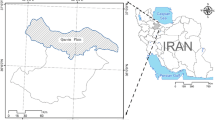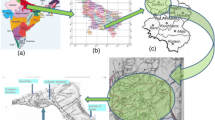Abstract
Agriculture is the major occupation of the people in Odisha state, India. More than seventy percentage of the population depend directly or indirectly on agriculture. In this work, cropping model is formulated for the study area to optimize the cropping pattern by using the Cuckoo Search technique to maximize the net annual benefit. The processes of crop planning and crop rotation have been given more emphasis, since optimal allocation of scarce water resources is highly necessary. To ensure correct assessment of the irrigation water availability, the sensor-based water measurement techniques such as ADV flow tracker and micro-ADV are used in the study. The crop water requirements of various crops are determined with CROPWAT software. The cropping models are developed by taking into account the opinion of local farmers and officials of agriculture department. The models are compared with the prevailing practice with respect to net annual benefits. The results indicate that that presently the farmers are getting benefits of 0.975 million USD. The cropping pattern suggested by LINDO yields a net benefit of 1.07 million USD per year. The optimal cropping pattern from Cuckoo Search technique yields a net benefit of 1.296 million USD.
Access this chapter
Tax calculation will be finalised at checkout
Purchases are for personal use only
Similar content being viewed by others
References
Alabdulkader, A.M., Al-Amound, A.I., Awad, F.S.: Optimization of the Cropping Pattern in Saudi Arabia Using a mathematical programming sector model. Agric. Econ. Czech 58(2), 56–60 ( 2012)
Fister, I., Fister, D., Fister, I.: A comprehensive review of cuckoo search: variants and hybrids. Int. J. Math. Modell. Numer. Optim. 4(4), 387–409 (2013)
FAO. Food and, : Agriculture Organization of the United Nations, Crop evapotranspiration guidelines for computing crop water requirements - FAO Irrigation and drainage paper, p. 56. Rome (1998)
Lalehzari, R., Nasab, S.B., Moazed, H., Haghighi, A.: Multi-objective Management of water allocation to sustainable irrigation planning and optimal cropping pattern. J. Irrig. Drain. Eng. 10.1061/ (ASCE) IR1943-4774.0000933, 05015008 (2015)
Fister, I., Fister, D., Fister, I.: Optimal reservoir management and crop planning using deterministic and stochastic inflows. Water Res. Bull. 16, 438–443 (1980)
Raju, K.S., Kumar, D.N.: Irrigation planning using genetic algorithms. Water Res. Manag. 18(163–176) (2004)
Reddy, M.J., Kumar, D.: Nagesh Evolving strategies for crop planning and operation of irrigation reservoir system using multi-objective differential evolution. Irrig. Sci. 26, 177–190 (2008)
Sharma, J.L.: Inter-state disparities in growth of agriculture in India. Agric. Situat. India 45(7), 453–456 (1990)
Singh, A.: Optimizing the Use of Land and Water Resources for maximizing farm income by mitigating the Hydrological Imbalances. J. Hydrol. Eng. 19(7), ASCE (2014). ISSN 1084-0699/2014/7-1447-1451
Feng Kuo, S., Jang Lin, B., Shieh, H.: CROPWAT model to evaluate crop water requirements in Taiwan. In: 1st Asian Regional Conference, Seoul (2001)
Sahoo, B., Lohani, A.K., Sahu, R.K.: Fuzzy multi-objective and linear programming based management models for optimal land-water-crop system planning. Water Resour. Manag. 20(6), 931–948 (2006)
Xu, Y.P., Tung, Y.K.: rules for water resources management under uncertainty J. Water Res. Planning. Manag. 135: 3(149), 149–159 (2009)
Yang, X.S., Deb, S.: Engineering Optimization by Cuckoo Search. Int. J. Math. Modell. Numer. Optim. 1(4), 330–343 (2010)
Yang, X.S., Deb, S.: Multiobjectives cuckoo search for design optimization. Comput. Oper. Res. 1616–1624 (2013)
Mohammadrezapour, O., Yoosefdoost, I., Ebrahimi, M.: Cuckoo optimization algorithm in optimal water allocation and crop planning under various weather conditions. Case study: Qazvin plain, Iran Neural Comput & Applic. (2017). https://doi.org/10.1007/s00521-017-3160
Acknowledgements
The authors thank the officials of Hirakud Dam authority and District Agriculture office, Sambalpur, for providing necessary assistance at the time of need to conduct this research.
Author information
Authors and Affiliations
Corresponding author
Editor information
Editors and Affiliations
Rights and permissions
Copyright information
© 2019 Springer Nature Switzerland AG
About this chapter
Cite this chapter
Rath, A., Samantaray, S., Swain, P.C. (2019). Optimization of the Cropping Pattern Using Cuckoo Search Technique. In: Mishra, M., Mishra, B., Patel, Y., Misra, R. (eds) Smart Techniques for a Smarter Planet. Studies in Fuzziness and Soft Computing, vol 374. Springer, Cham. https://doi.org/10.1007/978-3-030-03131-2_2
Download citation
DOI: https://doi.org/10.1007/978-3-030-03131-2_2
Published:
Publisher Name: Springer, Cham
Print ISBN: 978-3-030-03130-5
Online ISBN: 978-3-030-03131-2
eBook Packages: Intelligent Technologies and RoboticsIntelligent Technologies and Robotics (R0)




